The Cambrian Period was the first geological period of the Paleozoic Era, and of the Phanerozoic Eon. The Cambrian lasted 55.6 million years from the end of the preceding Ediacaran Period 541 million years ago (mya) to the beginning of the Ordovician Period 485.4 mya. Its subdivisions, and its base, are somewhat in flux. The period was established as "Cambrian series" by Adam Sedgwick, who named it after Cambria, the Latin name for 'Cymru' (Wales), where Britain's Cambrian rocks are best exposed. The Cambrian is unique in its unusually high proportion of lagerstätte sedimentary deposits, sites of exceptional preservation where "soft" parts of organisms are preserved as well as their more resistant shells. As a result, our understanding of the Cambrian biology surpasses that of some later periods.

A fossil is any preserved remains, impression, or trace of any once-living thing from a past geological age. Examples include bones, shells, exoskeletons, stone imprints of animals or microbes, objects preserved in amber, hair, petrified wood, oil, coal, and DNA remnants. The totality of fossils is known as the fossil record.

Kendall County is a county in the U.S. state of Illinois, within the Chicago metropolitan area. According to the 2010 census, it has a population of 114,736. Its county seat is Yorkville, and its most populous municipality is Oswego.

Oswego is a village in Kendall and Will Counties, Illinois, United States. The village population as of the 2010 census was 30,355, more than double its population of 13,326 in 2000. Oswego is the largest municipality in Kendall County.

A trace fossil, also ichnofossil, is a fossil record of biological activity but not the preserved remains of the plant or animal itself. Trace fossils contrast with body fossils, which are the fossilized remains of parts of organisms' bodies, usually altered by later chemical activity or mineralization. Ichnology is the study of such trace fossils and is the work of ichnologists.

Nautiloids are a large and diverse group of marine cephalopods (Mollusca) belonging to the subclass Nautiloidea that began in the Late Cambrian and are represented today by the living Nautilus and Allonautilus. Nautiloids flourished during the early Paleozoic era, where they constituted the main predatory animals, and developed an extraordinary diversity of shell shapes and forms. Some 2,500 species of fossil nautiloids are known, but only a handful of species survive to the present day.
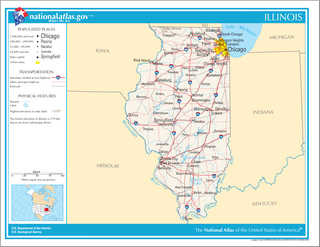
Illinois is in the midwestern United States. Surrounding states are Wisconsin to the north, Iowa and Missouri to the west, Kentucky to the south, and Indiana to the east. Illinois also borders Michigan, but only via a northeastern water boundary in Lake Michigan. Nearly the entire western boundary of Illinois is the Mississippi River, except for a few areas where the river has changed course. Illinois' southeastern and southern boundary is along the Wabash River and the Ohio River, whereas its northern boundary and much of its eastern boundary are straight survey lines. Illinois has a maximum north-south distance of 390 miles and 210 miles east-west. Its total area is 57,918 square miles (150,010 km2).
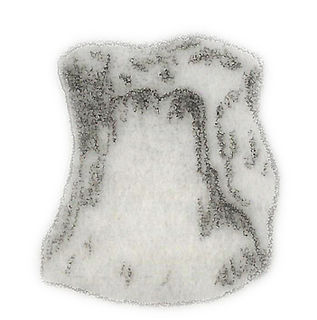
Tichosteus is a genus of herbivorous dinosaur from the Late Jurassic. It is known only from vertebrae recovered from Kimmeridgian rocks in the Morrison Formation, Colorado.
In the geological timescale, the Llandovery epoch occurred at the beginning of the Silurian period. The Llandoverian epoch follows the massive Ordovician-Silurian extinction events, which led to a large decrease in biodiversity and an opening up of ecosystems.
The geology of Illinois includes extensive deposits of marine sedimentary rocks from the Palaeozoic, as well as relatively minor contributions from the Mesozoic and Cenozoic. Ice age glaciation left a wealth of glacial topographic features throughout the state.
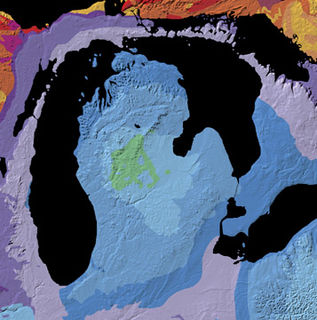
The Michigan Basin is a geologic basin centered on the Lower Peninsula of the U.S. state of Michigan. The feature is represented by a nearly circular pattern of geologic sedimentary strata in the area with a nearly uniform structural dip toward the center of the peninsula.

The geography of Indiana comprises the physical features of the land and relative location of U.S. State of Indiana. Indiana is in the north-central United States and borders on Lake Michigan. Surrounding states are Michigan to the north and northeast, Illinois to the west, Kentucky to the south, and Ohio to the east. The entire southern boundary is the Ohio River.

The Maquoketa Group is an assemblage of several geologic formations. It is Upper Ordovician in age and named for the Maquoketa River in Iowa. It exists in Missouri, Wisconsin, Iowa, Illinois, and Indiana. It is equivalent to the all but the basal formations of the Cincinnati Group in Ohio. Illinois and Indiana are the only states where the Maquoketa is considered a group. In other states it is a formation. The Maquoketa was deposited in a shallow intercontinental sea. Most of the clastic sediments are derived from the Appalachians, which were being raised at the end of the Ordovician. To a lesser degree some of the sediments were derived from the Ozark highlands to the southwest.
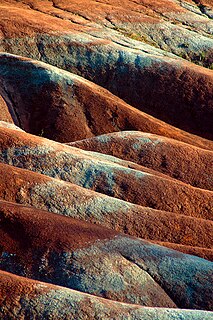
The Queenston Formation is a geological formation of Upper Ordovician age, which outcrops in Ontario, Canada and New York, United States. A typical outcrop of the formation is exposed at Bronte Creek just south of the Queen Elizabeth Way. The formation is a part of the Queenston Delta clastic wedge, formed as an erosional response to the Taconic Orogeny. Lithologically, the formation is dominated by red and grey shales with thin siltstone, limestone and sandstone interlayers. As materials, comprising the clastic wedge, become coarser in close proximity to the Taconic source rocks, siltstone and sandstone layers are predominant in New York.

Paleontology in Illinois refers to paleontological research occurring within or conducted by people from the U.S. state of Illinois. Scientists have found that Illinois was covered by a sea during the Paleozoic Era. Over time this sea was inhabited by animals including brachiopods, clams, corals, crinoids, sea snails, sponges, and trilobites.
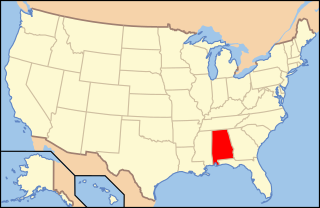
Paleontology in Alabama refers to paleontological research occurring within or conducted by people from the U.S. state of Alabama. Pennsylvanian plant fossils are common, especially around coal mines. During the early Paleozoic, Alabama was at least partially covered by a sea that would end up being home to creatures including brachiopods, bryozoans, corals, and graptolites. During the Devonian the local seas deepened and local wildlife became scarce due to their decreasing oxygen levels.

Paleontology in Wisconsin refers to paleontological research occurring within or conducted by people from the U.S. state of Wisconsin. The state has fossils from the Precambrian, much of the Paleozoic, and the later part of the Cenozoic. Most of the Paleozoic rocks are marine in origin. Because of the thick blanket of Pleistocene glacial sediment that covers the rock strata in most of the state, Wisconsin’s fossil record is relatively sparse. In spite of this, certain Wisconsin paleontological occurrences provide exceptional insights concerning the history and diversity of life on Earth.
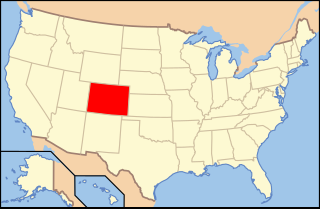
Paleontology in Colorado refers to paleontological research occurring within or conducted by people from the U.S. state of Colorado. The geologic column of Colorado spans about one third of Earth's history. Fossils can be found almost everywhere in the state but are not evenly distributed among all the ages of the state's rocks. During the early Paleozoic, Colorado was covered by a warm shallow sea that would come to be home to creatures like brachiopods, conodonts, ostracoderms, sharks and trilobites. This sea withdrew from the state between the Silurian and early Devonian leaving a gap in the local rock record. It returned during the Carboniferous. Areas of the state not submerged were richly vegetated and inhabited by amphibians that left behind footprints that would later fossilize. During the Permian, the sea withdrew and alluvial fans and sand dunes spread across the state. Many trace fossils are known from these deposits.

The Montoya Group is a group of geologic formations in westernmost Texas and southern New Mexico. It preserves fossils dating back to the late Ordovician period.
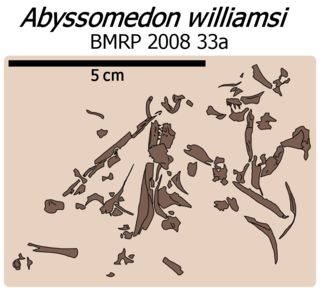
Abyssomedon is an extinct genus of a nyctiphruretid parareptile known from Early Permian fissure fills at Richards Spur in Comanche County, Oklahoma, south-central United States. It contains a single species, Abyssomedon williamsi, which represents oldest known nyctiphrureptid species and the first to be discovered in North America.

















